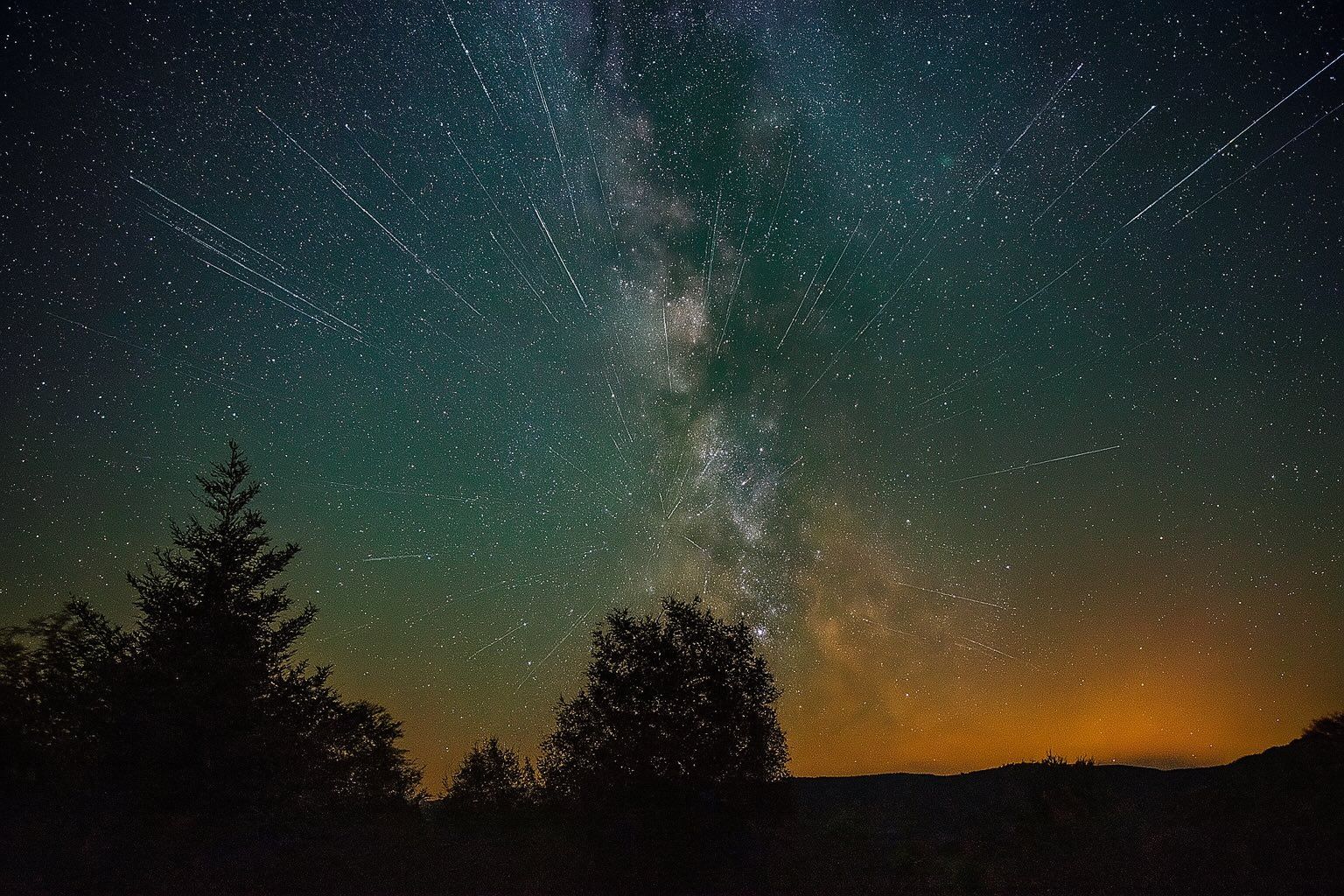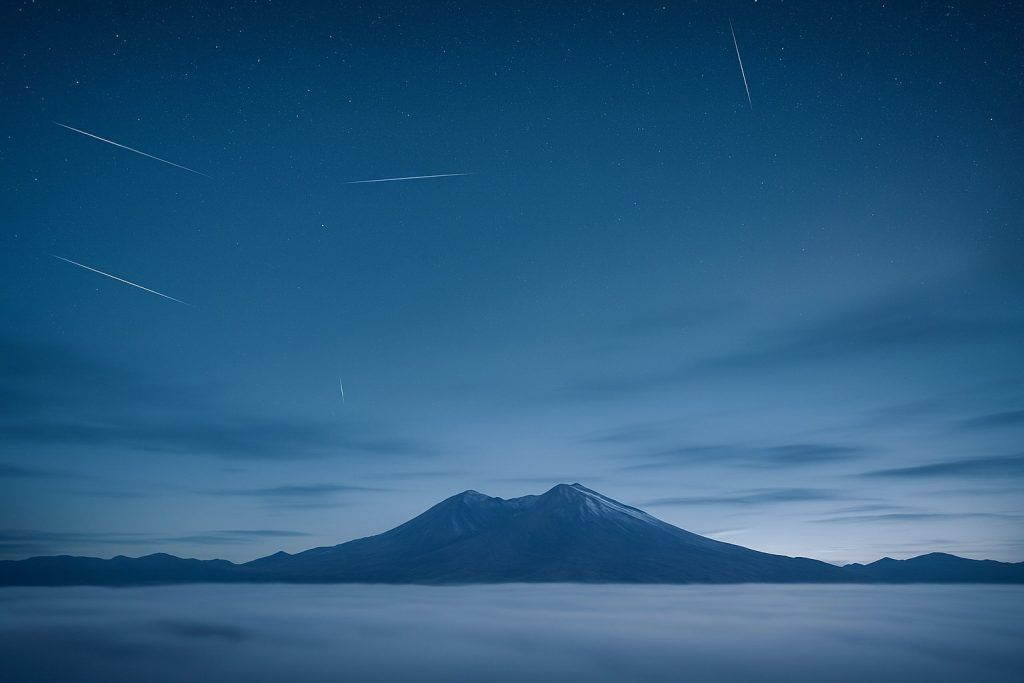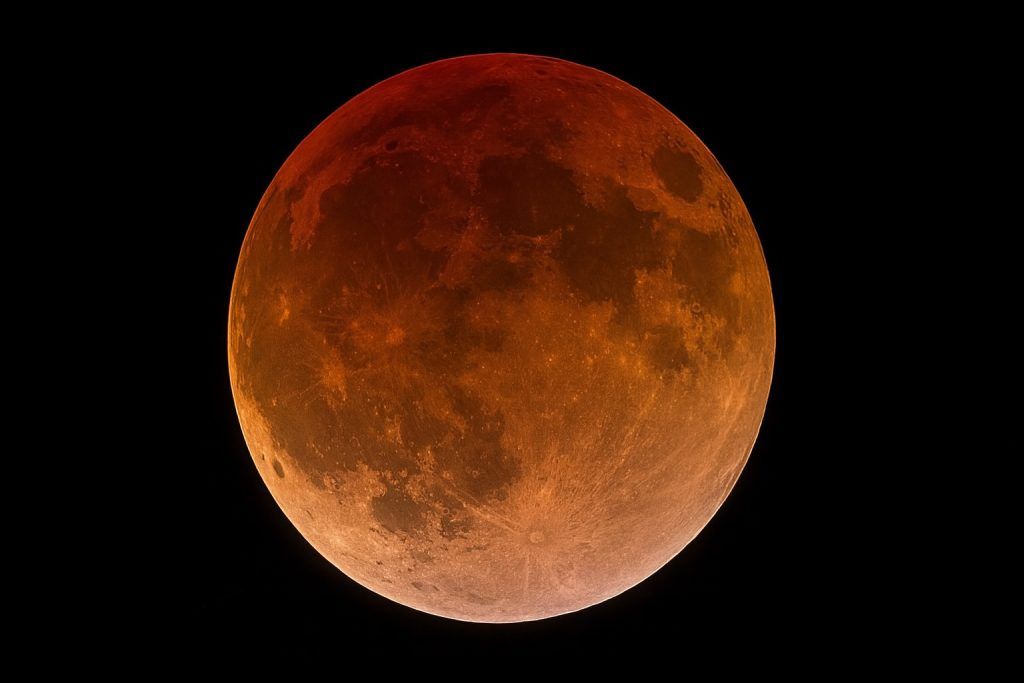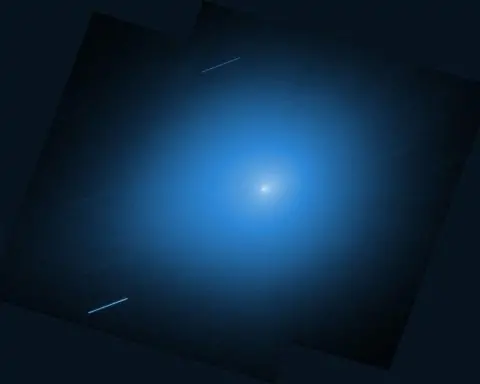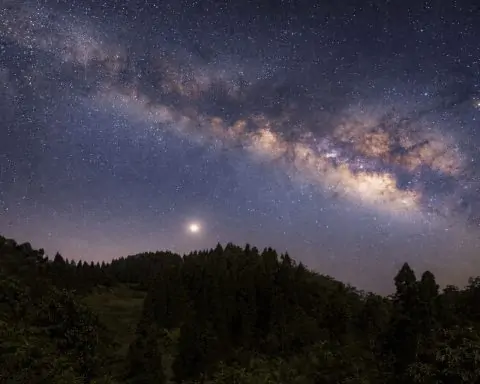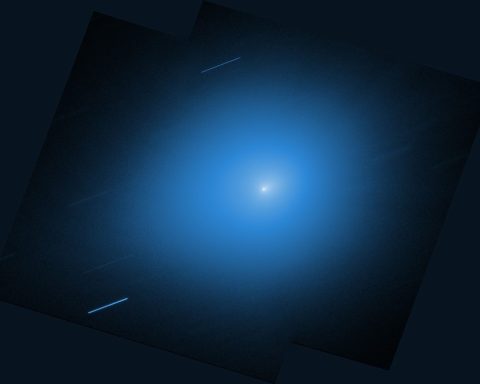- Perseid Meteor Shower peaks on the night of August 11–12 (into the pre-dawn of August 13), with up to about 100 shooting stars per hour under dark skies, though the August 9 full Sturgeon Moon at 84–90% illumination will wash out many dim meteors.
- On the morning of August 10, a rare six-planet parade will place Mercury, Venus, Jupiter, and Saturn visible to the naked eye, with Uranus and Neptune needing binoculars, and a nearly full Moon passing near Saturn.
- Aug 12 dawn sees a Venus–Jupiter conjunction with about 0.8 degrees separation; Venus at magnitude −4.0 and Jupiter at −1.9, minimum separation around 06:37 GMT, visible low about 45 minutes before sunrise.
- Mercury reaches greatest western elongation on August 19, about 18 degrees from the Sun, with magnitude around −0.1, representing its best dawn viewing of the year.
- August 19–21 features Moon–planet conjunctions in the dawn sky, with August 19 Moon (approximately 11% illuminated) near Jupiter, August 20 Moon near Venus around 10:51 GMT, and August 21 Moon near Mercury alongside the Beehive cluster (M44) and Pollux.
- Saturn is near edge-on rings in 2025 and will reach opposition on September 21, 2025, with magnitudes around +0.7 to +0.8, rising earlier each night and visible after midnight, Titan and Rhea visible as faint points.
- Jupiter dominates the late-night sky as a morning object in August, rising after midnight early in the month and by month’s end around 10–11 PM, with magnitude about −1.9 to −2.0 and Galilean moons observable in a telescope.
- Mars is fading after its January opposition, at about magnitude +1.6, visible only low in the western twilight in Virgo, making August a poor year for Mars observers with next favorable opposition not until 2027.
- There are no eclipses in August 2025, but a Total Lunar Eclipse will occur on September 7, 2025 visible in North America and a Partial Solar Eclipse on September 21, 2025 in parts of the Southern Hemisphere; the next major solar eclipse is August 2, 2027.
- New Moon on August 23, 2025 is called the Seasonal Black Moon, the third new moon in a summer with four new moons.
August 2025 brings a mixed bag of celestial spectacles for skywatchers. The famous Perseid meteor shower will peak under less-than-ideal moonlight, but the cosmos offers plenty of consolation prizes. A rare six-planet alignment will grace the dawn sky [1], Venus and Jupiter stage a dazzling close encounter [2], and the Sun’s heightened activity could spark vibrant auroras [3]. Below is a comprehensive guide to all the major skywatching events in August 2025 – from meteor “fireballs” and eclipses to planetary meet-ups, satellite reentries, and more – complete with expert insights and key viewing tips.
Perseid Meteor Shower – Bright Fireballs vs. Bright Moon
The Perseids are typically the headline event of August’s night sky, known for “bright blue meteors — and lots of them,” as astronomer Don Pollacco describes [4]. This annual shower, active from mid-July to late August, peaks on the night of August 11–12 (into the pre-dawn of Aug. 13). In a dark sky, the Perseids can produce up to ~100 shooting stars per hour at peak [5]. Many Perseids are swift and bright, often leaving long-lived glowing trails; NASA calls it “the best meteor shower of the year” for its plentiful, fast meteors that streak vividly across the sky [6].
Unfortunately, 2025 is not a perfect year for Perseid lovers. A full Sturgeon Moon on August 9 means the peak nights will have a waning gibbous moon (84–90% illuminated) rising mid-evening, which “will brighten the sky and wash out the dimmer meteors,” experts warn [7]. The moonlight will significantly reduce the visible meteor counts. Don’t despair – the Perseids are famous for producing numerous fireballs (exceptionally bright meteors). “The Perseids result from bigger particles than a lot of other showers,” notes Bill Cooke of NASA’s Meteoroid Environment Office, which means more “bright fireballs” that are easier to spot [8] even with moonlight in the sky.
- Peak Timing: The Perseid maximum is expected late Aug. 11 into Aug. 12 pre-dawn. Plan to watch after local midnight until dawn, when the Perseid radiant (in Perseus) climbs high. At that time, you might still catch 50–75 meteors per hour despite the lunar glare [9]. The American Meteor Society predicts “more than 50 meteors per hour, and potentially up to 75,” under the conditions this year [10] – lower than a moonless year, but still an impressive show.
- Viewing Tips: Find the darkest sky possible and avoid staring at the Moon. Seasoned observers suggest positioning yourself so that a building, hill, or trees block the Moon, keeping your eyes adapted to the dark [11]. Focus your gaze ~45° away from the Perseid radiant; meteors will appear longer and more dramatic at an angle from Perseus. No telescopes or binoculars are needed – just a comfy chair or blanket, and some patience. Give your eyes ~30 minutes to adapt to darkness, and enjoy the balmy summer night. Even a week after the peak, the Perseids will continue (fewer in number but under darker skies as the Moon wanes) [12], so you can try again on nights around August 17–19 when the crescent Moon sets earlier.
- Meteor Colors & Fireballs: Observers often report Perseid meteors with a bluish or greenish tint. “Swift and bright meteors that often leave long ‘wakes’ of light and color,” as NASA describes them [13], are a Perseid hallmark. These colors come from ionized gases and minerals (like magnesium or nickel) in the meteoroids. Thanks to the large comet fragments in the Perseid stream (debris of Comet 109P/Swift–Tuttle, which boasts one of the biggest nuclei of any near-Earth comet [14]), fireballs are frequent. Those brilliant meteors can rival Jupiter or Venus in brightness and remain visible even with moonlight. In short: the faint “shooting stars” will be wiped out by lunar glare, but dozens of Perseid fireballs could still blaze across the sky each hour – a thrilling sight if you catch one.
- Other Active Showers: While the Perseids steal the show, they overlap with a couple of minor showers. The Delta Aquariids (peaking around July 30) and Alpha Capricornids (peaking July 29–30) are tapering off in early August [15]. The Delta Aquariids produce a steady ~10–20 meteors per hour at best [16], and the Alpha Capricornids are sparse but known for slow, bright fireballs. You might spot an occasional Capricornid fireball in the first week of August, distinguishable by its slow speed and yellowish glow. These minor showers are a warm-up to the Perseids – and in 2025 they peaked under dark skies in late July, so some lucky stargazers caught extra meteors ahead of the Perseid rush.
“The Perseids are one of the most anticipated celestial events of the year,” local media noted [17]. Even if 2025’s display is somewhat muted, there’s ample enthusiasm among skywatchers. And take heart: next year (August 2026) the Perseids occur under a new moon, promising ideal conditions [18]. As Universe Magazine put it, “do not be disappointed by the unfavorable conditions of 2025: next year…the Perseids will once again provide us with true aesthetic pleasure.” [19] Mark your calendars for that cosmic encore – but first, enjoy what August 2025 has to offer!
Planetary Alignments and Conjunctions – A Parade of Planets
While the Perseids are contending with the Moon, the planets are putting on a show of their own in August. In fact, virtually every major planet is visible this month, several of them clustering in the morning sky. Here are the must-see planetary events and alignments:
- Aug 10 (Pre-Dawn): Six-Planet “Parade” – Early risers on August 10 can witness a rare alignment of six planets spanning the east and southern pre-dawn sky [20]. About an hour before sunrise, Mercury, Venus, Jupiter, and Saturn will all be visible to the naked eye, lined up across the sky. Uranus and Neptune will also be in the mix (near Jupiter and Saturn respectively), though those two outer planets require binoculars or a telescope to spot [21]. The planets won’t form a single file line, but will be scattered along the ecliptic from the east-northeast to the south – a spectacular sight nonetheless. Bright Venus and Jupiter anchor the lineup in the east, golden Saturn shines higher in the south, with faint Uranus in Taurus and Neptune in Pisces positioned between [22]. Adding to the scene, the nearly full Moon will be hovering below Saturn in Aquarius that morning [23]. Its glare will overwhelm dim Neptune, but the Moon alongside Saturn provides a dramatic visual cue for the alignment. Don’t miss this impressive planetary parade – such multi-planet lineups don’t happen every year. (Starwatchers note: the next chance to see six planets at once comes in February 2026 [24].)
- Aug 12 (Dawn): Venus–Jupiter Conjunction – The two brightest planets in our sky, Venus and Jupiter, are having an ultra-close meetup that will be one of the flashiest sights of the year. On the morning of August 12, Venus and Jupiter will appear only about 0.8° apart – that’s less than the width of your thumb at arm’s length! [25] Look east about 45 minutes before your local sunrise to spot this brilliant pair low on the horizon. Venus, the “Morning Star,” shines at magnitude –4.0 (dazzlingly bright), and Jupiter at around –1.9 [26] – together they’ll look like a double beacon rising in tandem. Many casual observers might mistake this eye-catching duo for “twin UFOs” or a single unusually bright object [27] – it’s that striking. “These two brilliant planets will appear so bright and close together that they might even be mistaken for a pair of UFOs!” one astronomy outreach site quipped [28]. In reality, Venus will lie just below Jupiter on Aug 12. Exact conjunction (minimum separation ~0°51′) occurs around 06:37 GMT [29], but the pair will be visibly close on both Aug 11 and Aug 13 as well. Viewing tip: You’ll need an unobstructed east-northeast horizon since Venus and Jupiter climb only a short distance above the horizon before the twilight grows bright. If you have binoculars or a small telescope, train them on Venus and Jupiter – you might catch Venus’s gibbous phase (appearing as a tiny half-lit disk) and some of Jupiter’s moons or cloud bands in the same field of view [30]. It’s not often you can see two planets through a telescope together! This conjunction serves, as one astronomer put it, as a “compensation” for the underwhelming Perseids this year [31] – a celestial consolation prize that’s free for all to enjoy.
- Aug 19: Mercury at Greatest Elongation – Elusive Mercury reaches its greatest western elongation on August 19, meaning it’s at its farthest apparent distance from the Sun in the morning sky. For observers, this translates to Mercury’s best dawn appearance of the year. On Aug 19, Mercury will be about 18° from the Sun [32] and shines around magnitude –0.1 (getting brighter each day) [33]. You can start looking for Mercury during the second half of August, about 30–45 minutes before sunrise, very low above the east-northeast horizon [34] [35]. It will appear as a modestly bright star-like point; binoculars help against the dawn glow. Each day after mid-month, Mercury climbs a bit higher and brightens – so if you’ve never seen Mercury, late August 2025 is an ideal opportunity. (Northern hemisphere observers have a favorable geometry this time; those in the Southern Hemisphere will also see Mercury low in the east, similarly improving through the month [36].)
- Aug 19–21: Moon Dances with Planets – As an added treat, a slender waning crescent Moon will join the planetary gathering in the mornings of Aug 19, 20, and 21. Mark these dates for some beautiful pre-dawn tableaux:
- Aug 19: The Moon (just ~11% illuminated) will meet Jupiter in the eastern sky [37]. Look around 4–5 AM local time: the delicate crescent will be positioned near bright Jupiter – a lovely contrast.
- Aug 20: The even thinner Moon slides below Venus around 10:51 GMT on the 20th [38]. Before sunrise on Aug 20, you’ll see Venus and a razor-thin lunar crescent close together – a classic photo opportunity. (Make sure to also look for earthshine on the dark side of the Moon.)
- Aug 21: The Moon’s last crescent sits very low but will form a grouping with Mercury before dawn [39]. By the 21st, the Moon is only ~5% lit and might be challenging to spot, but it creates a lineup with Mercury, Venus, and Jupiter all roughly in the same vicinity of the sky. Adding to the scene on Aug 21, the Beehive star cluster (M44) in Cancer and the bright star Pollux (in Gemini) will also be nearby, clustering with the Moon and planets [40]. It’s a lot of celestial objects in one small patch of sky – a great target for binoculars or wide-field photography.
- Saturn at Peak & “Ringless” Appearance:Saturn rises earlier each night in August and by month’s end it will be visible all night long. That’s because Saturn is nearing opposition (it will reach opposition on September 21, 2025, when it lies opposite the Sun in our sky and shines at its brightest of the year [42]). Throughout August, Saturn glows around magnitude +0.7 to +0.8 in the constellation Pisces [43] – not as brilliant as Jupiter, but easy to find as a golden “star” rising in the southeast by late evening. By midnight in mid-August, Saturn is high in the southern sky, and it remains observable until dawn. This is a great time to observe Saturn in a telescope: the planet’s disk is large and bright, though you’ll notice something unusual – Saturn’s rings are almost edge-on in 2025. In fact, around March 2025 Saturn’s rings turned nearly invisible from Earth’s perspective [44]. We are seeing Saturn’s ring system at a very shallow angle this year, a rare event that happens roughly every 15 years when Saturn’s orbit and tilt align just so. The rings won’t literally disappear (they’re still there, but seen edge-on they appear as a thin line). In backyard telescopes, Saturn may look like a strange oval or a disk with “ears” barely protruding. It’s a unique chance to witness Saturn in an almost “ringless” guise [45] – quite different from the wide open rings seen in recent years. By the end of August, the ring tilt starts opening up a tiny bit, but the view remains unusual. Saturn’s moons are also fun to spot: Titan, Rhea, and others will be visible as faint star-like points around the planet. And note Aug 12-13: on those nights the Moon will pass near Saturn (and Neptune) [46]. On Aug 12, the bright Moon will sit a few degrees below Saturn in Aquarius – a useful guide to finding Saturn even with the naked eye (look for the bright “star” just above the Moon).
- Other Planets:Jupiter is a morning object in Gemini, rising after midnight in early August and by 10–11 PM at month’s end. Aside from its conjunction with Venus, Jupiter will dominate the late-night sky with a brilliant white shine (brightening from mag –1.9 to –2.0 over the month [47]). If you have a telescope, Jupiter’s cloud belts and Galilean moons are on display in the pre-dawn hours – and watch for when the Moon joins Jupiter on Aug 19 as noted. Mars, on the other hand, is fading out of view this month. Having passed its own opposition back in January, Mars is now distant from Earth and visible only briefly at dusk. It lurks very low in the western evening twilight (in Virgo), at a modest magnitude ~+1.6 [48]. By August’s end, Mars is sinking into the Sun’s glare and will soon be in conjunction with the Sun (not visible). So 2025 is not a great year for Mars observers – we’ll have to wait for its next opposition in 2027 for a bright Mars in the sky. Uranus (magnitude ~5.7) and Neptune (mag ~7.8) require optical aid; Uranus is in Aries/Taurus, rising after midnight, and Neptune is near Saturn in Pisces (you might use Saturn as a signpost on Aug 6 when they’re only ~1° apart [49], as noted in the event list). Advanced observers can try to glimpse Uranus’s green disk or Neptune’s blue dot with a telescope during the darker moonless nights later in the month.
In summary, August 2025 is a feast for planet-watchers. As one stargazing guide enthused, “There’s something to see nearly every night!… now’s the time to head outside in the early evening or before dawn… August’s night sky won’t disappoint.” [50] From a planetary “grand alignment” to the spectacular Venus-Jupiter pairing, make sure to catch these sights – many are bright enough for casual viewers, so just look up!
Aurora Watch – High Solar Activity Brings Northern Lights Potential
If you live in high latitudes – or even mid-latitudes – keep your eyes on the north this August for possible aurora borealis displays. We are currently near the peak of Solar Cycle 25, meaning the Sun is more active now than it has been in a decade. In fact, in late 2024 NASA and NOAA announced the Sun had entered its maximum phase of the 11-year cycle, a period of heightened sunspots, flares and geomagnetic storms “which could continue for the next year.” [51] [52] As the Sun’s activity ramped up, “solar activity has led to increased aurora visibility” in recent months, NASA noted [53].
Solar Storms and Auroras:
During solar maximum, strong solar flares and coronal mass ejections (CMEs) frequently erupt from the Sun, sending bursts of charged particles toward Earth. When those particles interact with Earth’s magnetic field, they can trigger geomagnetic storms – the drivers of auroras. NOAA’s Space Weather Prediction Center expects additional solar storms in 2025, which will “lead to opportunities to spot auroras over the next several months,” even in places that don’t normally see the Northern Lights [54]. In other words, aurora activity is on the upswing, and August 2025 is as good a time as any for skywatchers to stay alert.
Auroras are notoriously hard to predict far in advance – unlike an eclipse or planetary alignment, we often only get a few days’ notice (at best) of a coming geomagnetic storm, based on solar observations. However, there are some indicators to watch: for instance, large sunspot groups facing Earth or recurring coronal holes in the Sun’s atmosphere can emit high-speed solar wind streams that enhance auroras. Space weather forecasts (from NOAA or other agencies) issue alerts when conditions favor auroras. As of early August, the Sun continues to produce frequent medium-sized flares. Any Earth-directed CME could mean a geomagnetic storm a day or two later.
Just this past year, the heightened solar activity has produced some memorable auroral events. For example, in late April and May 2024, a series of powerful flares and CMEs sparked the strongest geomagnetic storm in two decades – with auroras reported as far south as Spain and California. NASA noted this may have been “among the strongest displays of auroras on record in the past 500 years.” [55] Such extreme events are rare, but they highlight what’s possible during solar max. Even a moderate G2 or G3-level geomagnetic storm can push the auroral oval down into the northern-tier U.S., Europe, and Eurasia. August 2025 lies squarely in the active phase of the solar cycle, so auroral surprises are definitely possible.
If you’re eager to see the Northern Lights, here are a few tips for August:
- Track the Space Weather: Follow NOAA’s Space Weather Prediction Center updates or aurora alert apps. Look for alerts of geomagnetic storm watches (Kp index of 5 or higher). These often come 1-3 days ahead of a potential aurora event.
- New Moon = Dark Skies: The new moon on August 23 means the nights around late August will be moonless and dark – perfect for aurora viewing if a solar storm hits. If a CME is forecast to arrive around that date, aurora chasers will be in luck with truly dark skies [56].
- Location: High latitudes (e.g. Canada, Northern US states, Northern Europe, southern Australia/NZ, etc.) have the best chances. However, strong storms can push auroras to mid-latitudes. In 2025 already, auroras have been seen in places like Oregon, Germany, and Poland during big events. Get away from city lights for the best view; auroral glows are faint and can be drowned out by light pollution.
- Photography: Even if your eyes see only a greyish cloud, a long-exposure photograph might reveal the green and purple hues of an aurora. Many people on social media share stunning aurora photos after each event – a good reminder to look up when others in your region report an ongoing display.
Lastly, let’s not forget the Southern Lights (Aurora Australis) – August is still winter in the Southern Hemisphere, offering long nights. New Zealand, Tasmania, and southern parts of Argentina/Chile can get auroras under the right conditions. Solar activity affects both poles, so an Earth-directed solar storm could paint the southern skies as well.
In short, keep an eye on aurora forecasts throughout August. There may not be a specific date circled on the calendar, but the Sun could surprise us at any time. As NOAA’s Elsayed Talaat advised, reaching solar max “doesn’t mean this is the peak of activity… While the Sun is in its maximum period, the month that solar activity peaks won’t be known until after the fact.” [57] In the meantime, enjoy the increased chances of seeing Earth’s atmosphere light up in neon ribbons of green, red, and purple. Few experiences can match the thrill of seeing an unexpected aurora dancing overhead on a dark summer night.
No Eclipses This Month – But Big Ones Loom on the Horizon
Skywatchers hoping for an eclipse in August 2025 will have to be patient – there are no major eclipses during August. The rhythms of the Sun, Moon, and Earth don’t bring any alignments for a solar or lunar eclipse this month. However, just after August ends, a noteworthy eclipse is coming:
- Total Lunar Eclipse – September 7, 2025: Approximately a week after August concludes, the Moon will plunge into Earth’s shadow, resulting in a Total Lunar Eclipse (often called a “Blood Moon”). This eclipse on 7 September 2025 will be the first total lunar visible from the continental United States (and much of North America) since 2022 [58] [59]. It will occur in the predawn hours for North America (and in the evening for Asia). During totality, the Moon will likely glow a deep coppery-red – a beautiful spectacle for those in the visibility zone. If you’re in North or South America, mark your calendar for that event, as it’s one of the sky highlights of 2025 [60] [61].
- Partial Solar Eclipse – September 21, 2025: Later in September, the New Moon will graze the Sun, causing a partial solar eclipse on Sept. 21. This eclipse will be a more limited affair, visible primarily to those in the Southern Hemisphere – specifically New Zealand, parts of Antarctica, and the South Pacific [62]. It won’t be visible in Europe or the Americas. Although not in August, it’s worth noting for enthusiasts tracking the eclipse cycle.
Since August itself has no eclipse events, it’s a good time to prepare for the eclipses ahead. For the September lunar eclipse, observers in the Americas should get their binoculars and cameras ready. And looking further out, the next total solar eclipse after 2024 will occur in August 2026 over the Arctic and Europe, followed by the much-anticipated “Eclipse of the Century” on August 2, 2027 (a whopping 6-minute-long total solar eclipse over parts of Africa and the Middle East) [63]. That 2027 event is already being dubbed “the eclipse of the century” for its exceptional duration [64] – but despite some internet rumors (discussed below), none of these eclipses will make the entire world go dark at once.
Moon Phases & “Black Moon” Trivia:
August 2025’s lunar phases still offer some points of interest:
- The Full Moon on August 9 is traditionally called the Sturgeon Moon in North America [65]. It reaches 100% illumination at 3:55 a.m. EDT on Aug. 9 [66]. This will be a bright moon that unfortunately coincides with Perseid week. You may notice it looking especially large and golden when it’s near the horizon on the nights of Aug 8 and 9 – a lovely sight for casual viewing or photography. (Despite appearing large, this is an optical illusion – the Moon’s size doesn’t actually change, just our perception against the horizon.)
- Notably, this is not a “supermoon.” A supermoon is a full moon that occurs near the Moon’s closest approach (perigee), making it appear slightly bigger and brighter than average. In 2025, the first supermoon will actually happen later – on October 21, 2025 [67]. August’s full moon is at a more average distance, so it’s a regular full moon, not unusually large. The term “Blue Moon” often comes up in August discussions (since August 2023 had two full moons, with the second called a Blue Moon). In August 2025, however, there is only one full moon (no Blue Moon this year).
- The New Moon on August 23, 2025 is interestingly termed a “Seasonal Black Moon.” A Black Moon isn’t an official astronomical term but is colloquially used for a second new moon in a calendar month or the third new moon in a season that has four. In this case, summer 2025 (June solstice to Sept equinox) has four new moons, and the Aug 23 new moon is the third, thus earning the “Seasonal Black Moon” nickname [68]. This has no effect on observation (you won’t see anything – it’s a new moon, after all, i.e. an invisible phase). But it’s a fun bit of lunar trivia for calendar watchers. The main takeaway is that around Aug 23, the sky will be fully dark with no moonlight – great for stargazing, meteor spotting, and viewing the Milky Way swath across summer skies [69].
- One more lunar event: in some regions, the half-lit Last Quarter Moon on Aug 16 will occult the Pleiades star cluster in the early morning hours. This means the Moon will pass in front of the glittering Pleiades (Seven Sisters) for a short time. Occultations like that are mainly of interest to dedicated observers with telescopes – if you’re in Western North America or Pacific regions before dawn Aug 16, you might see Pleiades stars “wink out” behind the Moon and reappear an hour or so later. For the casual observer, the Moon will simply be near the Pleiades before sunrise that day, which is a pretty sight in its own right.
Satellite Reentries – Shooting Stars of the Space Age
Not all things streaking through the August night sky are natural meteors – some are human-made objects returning to Earth. Satellite and rocket body reentries can produce brilliant flares and fragmentation trails that look a lot like meteors, except they move a bit slower and often break into multiple pieces. While these events are generally unpredictable long in advance (and no specific high-profile reentry has been scheduled as a public event for August 2025), it’s worth understanding this quieter side of skywatching.
Each year, dozens of defunct satellites, spent rocket stages, and bits of space debris reenter Earth’s atmosphere. Most are uncontrolled reentries, meaning the object simply falls when orbital decay brings it low enough, and we have only an estimate of when and where it will burn up. These often happen without anyone noticing, usually over the ocean. However, larger objects can put on a sky show: as they tear through the atmosphere at thousands of miles per hour, they ignite and fragment, sometimes visible as a slow-moving fireball streak that lasts several seconds. People who witness such an event might think they’ve seen a huge meteor or even a crashing aircraft. In reality, they may have caught the fiery return of a piece of space hardware.
In recent years, some reentries have grabbed headlines – for example, uncontrolled reentries of large Chinese rocket stages have been widely followed. In 2020–2022, parts of China’s Long March 5B rockets reentered unpredictably, leading to brief global excitement (and a bit of concern) until they finally splashed into remote ocean areas. These events underscore the fact that “atmospheric reentries happen regularly” and that most debris burns up harmlessly [70].
Space agencies are trying to reduce the risks of reentry debris. The European Space Agency (ESA) has even begun targeted reentries of old satellites – deliberately guiding them down over uninhabited ocean regions to ensure any surviving debris poses minimal risk. For instance, ESA’s Aeolus Earth-observation satellite was directed to reenter safely in July 2023, and in September 2024 one of the Cluster science satellites (“Salsa”) was steered to burn up over the South Pacific [71] [72]. More are coming: “Rumba is set to reenter in 2025, and Samba and Tango in 2026,” ESA notes of the remaining Cluster spacecraft [73]. This is part of a broader commitment to a “Zero Debris” policy by 2030 – ensuring operators remove their satellites at end-of-life rather than leaving them in orbit [74]. Each controlled reentry like this is studied by engineers, and sometimes even observed from aircraft, to learn how objects break up – a rare opportunity since most reentries are uncontrolled and unobserved [75].
For skywatchers, the bottom line is: keep an eye out for odd-looking fireballs. If you ever see a long-lasting fireball that breaks into multiple glowing pieces, especially if it’s moving a bit slower than a typical meteor, you might have witnessed a satellite reentry. These can occur at any time (often they’re unannounced until perhaps an hour prior, when tracking data pinpoints reentry time). Many happen over the oceans or broad unpopulated areas, but occasionally people on the ground get a view. One famous case: in July 2020, a Japanese skywatcher captured a spectacular video of a Japanese rocket stage reentry; in March 2021, residents of the U.S. Pacific Northwest were startled by a chain of bright lights – later identified as a SpaceX Falcon 9 upper stage reentering.
August 2025 does not have any known big reentries scheduled for public viewing. However, it’s always possible an old satellite succumbs to gravity this month. (Notably, NASA’s retired Transit 5B-5 navigation satellite, in orbit since 1965, was predicted to reenter in mid-2025 – if it hasn’t already, it could come down around this timeframe.) The U.S. Space Command and private groups like The Aerospace Corporation’s CORDS provide reentry predictions a few days out for larger objects [76]. Most pass without fanfare.
In summary, satellite reentries are a subtle skywatching category – not as celebratory as meteor showers, but intriguing when they occur. If you’re very lucky, you might catch a brief, unpredicted “man-made meteor” lighting up the sky. And on the space policy side, it’s encouraging to see agencies making efforts to avoid uncontrolled reentries [77] [78]. By 2025, responsible satellite operators plan deorbit burns to ensure their craft land in the ocean rather than randomly dropping debris. So, the chances of accidentally seeing a reentry may actually decrease in the future – enjoy the wild light shows while they last, but perhaps from a safe distance!
Debunking the “Earth Goes Dark” Rumor (August 2 Hoax)
A bit of astronomy folklore / misinformation made the rounds on social media this summer: a viral claim that “the world will go dark for six minutes” on August 2, 2025. If you saw this sensational headline, rest assured – it’s false. “It won’t [happen]. How could it? There will be no global blackout,” wrote science journalist Jamie Carter, responding to the rumor [79]. The claim suggested some planetary alignment or rare eclipse would plunge the entire Earth into darkness for several minutes on that date, not to happen again for 100 years. This is not grounded in any astronomical reality. No alignment of planets can cause a global blackout (the planets don’t affect our light in that way), and no eclipse can be seen everywhere on Earth at once – a solar eclipse’s shadow covers at most a small strip of the Earth.
What likely sparked this viral hoax is a misunderstanding of an upcoming eclipse that is special, but not in 2025. On August 2, 2027, there will be a total solar eclipse with an extraordinarily long duration – up to 6 minutes 22 seconds of totality at maximum [80]. It’s being called the “eclipse of the century” because it will be the longest total solar eclipse visible on land in the 21st century [81]. Perhaps someone misinterpreted news of that 2027 eclipse and thought Aug 2 of this year would see something dramatic. But even in 2027, the eclipse’s darkness is local, not global. The Moon’s shadow will race along a path about 160 miles wide [82], from Morocco and Spain across North Africa and the Middle East. While those under the path will experience “night in midday” for a few minutes, the rest of the world will carry on in daylight. There is never a time when the entire Earth goes dark, short of nighttime falling as the planet rotates.
So to be absolutely clear: August 2, 2025 had no unusual global darkness. If you noticed anything, it was just a normal day/night cycle or perhaps some local clouds! This serves as a reminder to be skeptical of sensational space rumors. When in doubt, check sources like NASA or reputable astronomy outlets. In this case, multiple science communicators quickly debunked the claim [83], and pointed out the real event to look forward to is the 2027 total solar eclipse (for which many eclipse-chasers are already excited). As fun as it is to imagine a worldwide blackout (sounds like a plot from a sci-fi movie), the cosmos had other plans for us in 2025 – like the more benign and enjoyable events we’ve detailed above.
Bottom line: August 2025 is packed with skywatching opportunities. Meteor enthusiasts get their annual fix with the Perseids (tempered by moonlight, but still worth watching for those spectacular fireballs [84]). Planet-gazers will relish the rare sight of six planets at once [85] and an exceptional Venus-Jupiter conjunction [86], plus quality time with Saturn and a handy Mercury appearance. Aurora seekers have reason to stay vigilant amid an active Sun [87]. And even though no eclipse falls in August, the celestial calendar marches on – setting the stage for a dramatic lunar eclipse soon after. There’s a little something for everyone, whether you’re armed with a telescope or just your curiosity. As one guide aptly said: “August’s night sky won’t disappoint.” [88] Clear skies, and happy skywatching!
Sources:
- NASA / NOAA Solar Cycle & Aurora Outlook [89] [90]
- Space.com – 2025 Skywatching Highlights by J. Rao [91] [92]; “Earth won’t go dark” debunk by J. Carter [93] [94]
- Star Walk (Vito Tech) – August 2025 Sky Events Guide [95] [96]
- Universe Magazine – “Sky in August 2025” (N. Virnina) [97] [98]
- Local12 News – Perseid Meteor Shower 2025 (WKRC) [99] [100]
- American Meteor Society – Perseids 2025 Outlook [101]
- Planetary Society – Space Events 2025 Calendar [102] [103]
- European Space Agency – Cluster Satellite Reentry FAQ [104] [105]
References
1. starwalk.space, 2. starwalk.space, 3. science.nasa.gov, 4. local12.com, 5. starwalk.space, 6. local12.com, 7. starwalk.space, 8. local12.com, 9. local12.com, 10. local12.com, 11. universemagazine.com, 12. starwalk.space, 13. local12.com, 14. local12.com, 15. local12.com, 16. local12.com, 17. local12.com, 18. universemagazine.com, 19. universemagazine.com, 20. starwalk.space, 21. starwalk.space, 22. starwalk.space, 23. starwalk.space, 24. starwalk.space, 25. starwalk.space, 26. starwalk.space, 27. starwalk.space, 28. starwalk.space, 29. starwalk.space, 30. starwalk.space, 31. universemagazine.com, 32. universemagazine.com, 33. starwalk.space, 34. starwalk.space, 35. starwalk.space, 36. starwalk.space, 37. starwalk.space, 38. starwalk.space, 39. starwalk.space, 40. starwalk.space, 41. starwalk.space, 42. www.planetary.org, 43. starwalk.space, 44. www.planetary.org, 45. www.planetary.org, 46. universemagazine.com, 47. starwalk.space, 48. starwalk.space, 49. universemagazine.com, 50. starwalk.space, 51. science.nasa.gov, 52. science.nasa.gov, 53. science.nasa.gov, 54. science.nasa.gov, 55. science.nasa.gov, 56. starwalk.space, 57. science.nasa.gov, 58. www.space.com, 59. www.planetary.org, 60. www.planetary.org, 61. www.planetary.org, 62. www.planetary.org, 63. www.space.com, 64. www.space.com, 65. www.space.com, 66. www.space.com, 67. starwalk.space, 68. universemagazine.com, 69. starwalk.space, 70. orbitaltoday.com, 71. www.esa.int, 72. www.esa.int, 73. www.esa.int, 74. www.esa.int, 75. www.esa.int, 76. aerospace.org, 77. www.esa.int, 78. www.esa.int, 79. www.space.com, 80. www.space.com, 81. www.space.com, 82. www.space.com, 83. www.space.com, 84. local12.com, 85. starwalk.space, 86. starwalk.space, 87. science.nasa.gov, 88. starwalk.space, 89. science.nasa.gov, 90. science.nasa.gov, 91. www.space.com, 92. www.space.com, 93. www.space.com, 94. www.space.com, 95. starwalk.space, 96. starwalk.space, 97. universemagazine.com, 98. universemagazine.com, 99. local12.com, 100. local12.com, 101. local12.com, 102. www.planetary.org, 103. www.planetary.org, 104. www.esa.int, 105. www.esa.int
